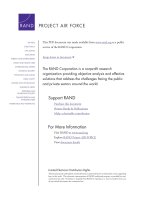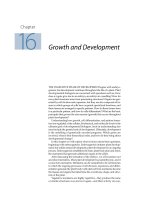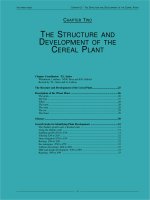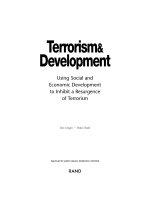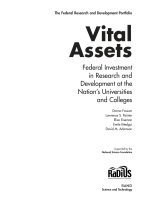Multiple view product representation and development using augmented reality technology
Bạn đang xem bản rút gọn của tài liệu. Xem và tải ngay bản đầy đủ của tài liệu tại đây (3.23 MB, 215 trang )
MULTIPLE-VIEW PRODUCT REPRESENTATION
AND DEVELOPMENT USING AUGMENTED REALITY
TECHNOLOGY
SHEN YAN
B. E (with Distinction)
A THESIS SUBMITTED
FOR THE DEGREE OF DOCTOR OF PHILOSOPHY
DEPARTMENT OF MECHANICAL ENGINEERING
NATIONAL UNIVERSITY OF SINGAPORE
2010
i
Acknowledgements
I would like to express my deepest appreciation to my supervisors, A/P S. K. Ong
for her constant and invaluable encouragement. Without her guidance and persistent
help, this research would not have been possible. She can always look deeper into
research and bring me down to the earth to make the research more applicable. I
benefited much from her critiques in an intellectually constructive manner. At the
beginning of my project when I was lost in a lot of new fields of knowledge, she had
encouraged me a lot to insist on and reminded me to do more practices. I really
appreciate her character such as hard-working and never giving up. I think her
working attitude has affected me and given me the power to continue.
Also I am indebted to my co-supervisor, Prof. A. Y. C. Nee for his valuable ideas
and assistance during the course of this research work. He can always lead the
correct direction for the research using his keen insight and erudite knowledge. His
serious attitude to research and science has always impressed and directed me during
the study. From his way of working and communicating, I have learned a lot.
Special thanks to my lab mates for their grateful sharing, helps and encourages.
They are Dr. Yuan Miaolong, Dr. Pang Yan, Dr. Jonathan Chong, Poh Yang Liang,
Zhang Jie, Louis Fong, Fang Hongchao, Dr. Gao Xinting and Dr. Chi Yanling.
ii
Words alone cannot express my gratitude to my parents for their love,
encouragement and support throughout my period of research and since I was born.
It is their support and trust that bring me to reach this point in life. Most important of
all, I would like to thank my husband for his unselfish love and support. He has
encouraged me throughout the whole course of my work.
Finally, I wish to thank the National University of Singapore for rewarding me with
a Research Scholarship and the Department of Mechanical Engineering for the help
they both have provided.
iii
Table of Contents
ACKNOWLEDGEMENTS I
TABLE OF CONTENTS III
LIST OF FIGURES VI
LIST OF TABLES IX
LIST OF ABBREVIATIONS X
LIST OF SYMBOLS XII
ABSTRACT XIV
CHAPTER 1. INTRODUCTION 1
1.1 MULTIPLE-VIEW PRODUCT REPRESENTATION 3
1.2
MULTIPLE-VIEW PRODUCT DEVELOPMENT 6
1.3
RESEARCH MOTIVATIONS AND OBJECTIVES 8
1.4
RESEARCH SCOPE 9
1.5
ORGANIZATION OF THE THESIS 10
CHAPTER 2. RESEARCH BACKGROUND 13
2.1 COLLABORATIVE DESIGN AND MANUFACTURING SYSTEMS 13
2.1.1
Collaborative Design Systems 14
2.1.2
Client-server based Collaborative Systems 16
2.1.3
Other Collaborative Systems 21
2.1.4
Virtual Reality Based Collaborative Systems 23
2.2
AUGMENTED REALITY TECHNOLOGY 24
2.2.1
Technical Issues in AR 25
2.2.1.1 Display Devices 26
2.2.1.2
Tracking 28
2.2.1.3
Interaction Techniques 30
2.2.2 AR Applications 33
2.2.2.1 Indoor AR-based Systems 33
iv
2.2.2.2 Outdoor AR-based Systems 36
2.3 MULTIPLE-VIEW PRODUCT REPRESENTATION AND DEVELOPMENT 40
2.3.1
AR-based Collaborative and Distributed Design Systems 40
2.3.1.1 Visualization-based AR Collaborative Design Systems 41
2.3.1.2
Co-design AR-based Collaborative Design Systems 45
2.3.1.3
Discussions 46
2.3.2 Solid Modeling in AR/VR Environment 48
2.3.3
View Management in AR 52
2.3.4
Benefits of Applying AR in Multiple-view Product Representation and Development 54
2.4
SUMMARY 56
CHAPTER 3. DETAILED SYSTEM DESCRIPTIONS 57
3.1 OVERALL SYSTEM ARCHITECTURE 57
3.2
TRI-LAYER PRODUCT REPRESENTATION 63
3.3
MARKER-BASED TRACKING METHOD 67
3.4
INTERACTION TECHNIQUES 68
3.5
SUMMARY 72
CHAPTER 4. VIEW MANAGEMENT IN AN AR-BASED ENVIRONMENT 74
4.1 VIEW MANAGEMENT 74
4.1.1 Annotation Representation 74
4.1.2
Review of Existing Related Methods 76
4.1.3
Evaluation Criteria 80
4.2
ENHANCED CLUSTER-BASED GREEDY ALGORITHM FOR VIEW MANAGEMENT 81
4.3
BENCHMARKING AND DISCUSSION 85
4.3.1
Benchmarking Scenario 86
4.3.2
Benchmarking Results and Discussion 89
4.4
SUMMARY 92
CHAPTER 5. PRODUCT INFORMATION VISUALIZATION 93
5.1 HISTORY DOCUMENT RETRIEVAL BASED ON USERS’ REQUIREMENTS 93
5.1.1
History Document Recording 94
5.1.2
Retrieving Design History Document 96
5.2
PRODUCT FEATURE INFORMATION DISPLAY 100
5.2.1
Feature Annotations 101
5.2.2
Annotation Creation and Sharing 101
5.2.3
Feature Visibility 104
5.2.4
View Management of the Annotations 106
5.2.5
Extended View Management Strategy 111
5.3
SUMMARY 117
v
CHAPTER 6. PRODUCT DEVELOPMENT IN A MULTI-USER
ENVIRONMENT 119
6.1 COLLABORATION MECHANISMS BETWEEN MULTIPLE USERS 119
6.2
SERVER INTERFACE 122
6.3
CLIENT INTERFACE 124
6.4
GRID-AND-SNAP MODES 125
6.5
DYNAMIC DISPLAY OF MODELING EFFECT 127
6.6
FEATURE OPERATIONS 130
6.6.1
Adding Features 133
6.6.2
Feature Removal 140
6.6.3
Feature Parameter Modification 141
6.7
MODEL SYNCHRONIZATION 142
6.8
CONSTRAINT-BASED COLLABORATION BETWEEN CLIENTS 144
6.9
CASE STUDIES 146
6.9.1
Product Modifications by Distributed Users 147
6.9.2
Constraint-based Modeling 149
6.10
SURVEY 152
6.11
SUMMARY 157
CHAPTER 7. CONCLUSIONS AND RECOMMENDATIONS 158
7.1 CONTRIBUTIONS 158
7.2
RECOMMENDATIONS 162
PUBLICATIONS FROM THIS RESEARCH 165
REFERENCES 166
APPENDIX A INTRODUCTION TO OPENCSG LIBRARY 187
APPENDIX B ENCODING THE TRANSFERRED INFORMATION 190
APPENDIX C THE QUESTIONNAIRE USED IN THE SURVEY 194
vi
List of Figures
Figure 1.1: The Working Scenario of the Co-located Users 3
Figure 2.1: Virtual Continuum [Milgram and Kishino 1994] 25
Figure 2.2: (a) Optical See-through HMD, (b) Video See-through HMD [Azuma
1997] 27
Figure 2.3: Virtual Object Rendered on a Marker 29
Figure 2.4: Interaction Units as Tangible Interfaces [Broll et al. 2000] 33
Figure 2.5: AR Applications: (a) Maintenance [Feiner et al. 1993], (b) Scientific
Visualization [Schmalsteig et al. 1998], (c) Medicine [State et al. 1996], and (d)
Assembly [Mizell 2001] 35
Figure 2.6: Working in Construct3D [Kaufmann and Schmalstieg 2003] 36
Figure 2.7: AR View of Infinite Planes Buildings [Piekarski 2004] 39
Figure 3.1: System Architecture 58
Figure 3.2: Information Flow during Product Modification in the AR-based
Environment 62
Figure 3.3: The Structure of Part Feature Tree 63
Figure 3.4: Tri-layer Structured Product Representation 64
Figure 3.5: Constraint-based Part Structure 65
Figure 3.6: Diagram of ARToolKit [ARToolKit Documentation] 68
Figure 3.7: Original Button 71
Figure 3.8: Depressed Button 71
vii
Figure 4.1: Annotation Representation 76
Figure 4.2: Flowchart for Clustering 83
Figure 4.3: Cost Calculation Pseudo Code 84
Figure 4.4: Pseudo Code of the Enhanced Cluster-based Greedy Algorithm 85
Figure 4.5: Annotation Layout without View Management 87
Figure 4.6: Annotation Layout with the Greedy Algorithm 87
Figure 4.7: Annotation Layout with the Cluster-based Algorithm 88
Figure 4.8: Layout with the Enhanced Cluster-based Greedy Method 88
Figure 5.1: Retrieving using Editing Time 97
Figure 5.2: Retrieving using Feature Name 98
Figure 5.3: Zooming into the Interface 99
Figure 5.4: Corresponding Model of the Selected Record 100
Figure 5.5: Annotation Creation Interface 102
Figure 5.6: Annotation Display 103
Figure 5.7: Displaying the Annotations without Visibility Check 105
Figure 5.8: Flowchart for Checking the Visibility of Annotation Points 106
Figure 5.9: Annotations Display without View Management 107
Figure 5.10: Bounding Rectangle of Model’s 2D Projection 108
Figure 5.11: Rectangular Representation of the 3D Model 109
Figure 5.12: Annotations Layout through the Enhanced Cluster-based Greedy
Algorithm 110
Figure 5.13: View Management with Adjustable Radius 112
viii
Figure 5.14: Pseudo Code for Cost Calculation 113
Figure 5.15: Avoiding Overlapping between Multiple Virtual Objects 114
Figure 5.16: Annotating the Epson Projector from Different Viewpoints 116
Figure 6.1: The Server Interface 123
Figure 6.2: 3D Grid Aligned with a Face 125
Figure 6.3: 2D Grid with the Feature Sketch 126
Figure 6.4: Feature Adding Process 128
Figure 6.5: Dynamic Display of a Subtractive Feature 129
Figure 6.6: Updating 3D Model Dynamically with a 2D Sketch 130
Figure 6.7: Modeling Process in AR 131
Figure 6.8: Defining Parameters during the Feature Adding Process 132
Figure 6.9: Flowchart for Highlighting Feature Entities 132
Figure 6.10: SCPs of a Block, Cylinder and a Cone 134
Figure 6.11: Coordinate Systems Transformations 135
Figure 6.12: The Dragging Process 137
Figure 6.13: Creating a Feature from a Free Hand Sketch 138
Figure 6.14: The Process of Creating a Fillet Feature 140
Figure 6.15: Highlighting the Removed Feature 141
Figure 6.16: Constraint-based Collaboration during Solid Modeling 145
Figure 6.17: Case Study 1 148
Figure 6.18: Case Study 2 151
Figure A.1: a) CSG Concave, b) CSG Grid [OpenCSG] 189
ix
List of Tables
Table 2.1: Comparison of Optical and Video See-through HMDs (compiled from
[Rolland et al. 1994, Azuma 1997]) 27
Table 2.2: Maximum Error Values for Four Tracking Distances [Malbezin et al.
2002] 30
Table 4.1: Comparison of the Three Methods with 20 Annotations (trial size n =
535) 89
Table 4.2: Comparison of the Three Methods with 32 Annotations (trial size n =
535) 92
Table 5.1: Database of History Document 94
Table 6.1: Results of User Study 155
Table C.1: Data Collection 196
x
List of Abbreviations
CAD Computer-Aided Design
AR Augmented Reality
HMD Head Mounted Display
SOAP Simple Object Access Protocol
VR Virtual Reality
DVE Distributed Virtual Environment
STEP STandard for the Exchange of Product model data
CSM Collaborative Solid Modeling
CVR Collaborative Virtual Reality
VE Virtual Environment
GPS Global Position System
MR Mixed Reality
PCB Printed Circuit Board
DOF Degree-of-freedom
PIP Personal Interaction Panel
TUI Tangible User Interface
VirIP Virtual Interaction Panel
RCE Restricted Coulomb Energy
CSG Constructive solid geometry
ECRC European Computer-Industry Research Center
xi
IT Information Technology
API Application Programming Interface
SCP Shape Control Point
LCS Local Coordinate System
WCS World Coordinate System
CPU Central Process Unit
PDM Product Data Management
xii
List of Symbols
[Chapter 4]
x
1
, y
1
x
the coordinates of the rectangle’s bottom left vertex
2
, y
2
w, h the dimensions of the rectangle in x direction and y direction
the coordinates of the rectangle’s up right vertex
a the angle between the linking line and the x direction
r the length of the linking line
[Chapter 6]
M
a
b
transformation matrix relating coordinate system b with
respect to coordinate system a
i
R
rotation matrix
i
T
translation matrix
ρ
an arbitrary factor
A matrix of camera intrinsic parameters
R, t extrinsic camera parameters
X, Y, Z 3D Euclidean space coordinates
u, v the image coordinates in pixel unit
c
Z
camera coordinates in mm unit
zyx
scpiscpiscpi ,,
the 3D space coordinates of the i
th
w, l, h the width, length and height of a block
SCP
d, h the diameter and height of a cylinder
xiii
d
1
, d
2
x = {x
, h the base diameter, top diameter and height of a cone
1
, x
2
, x
3
…} the manipulation information transferred between clients and
server
xiv
Abstract
Collaborative design among multiple users has become more important with intense
competition between companies. Augmented Reality (AR) technology in which
virtual objects are rendered in the real world is an efficient tool to facilitate
collaborative design among multiple users. In this research, an AR-based
collaborative design system has been developed to support product representation
and development among multiple users with an intuitive AR interface.
This thesis reports a research on the development of a novel system for collaborative
product design. A server/client framework has been developed for communication
among distributed or co-located users during a collaborative design process. With
this framework, multiple users from both upstream and downstream processes of a
product life cycle can participate in the design process to minimize redesign and
improve design efficiency. To support collaborative product design and visualization
in an AR-based environment, a tri-layer scheme product representation has been
designed. The constraint-based model in this scheme is employed to ensure that the
product models are kept updated and consistent in the different views through
presetting certain domain constraints based on the users’ requirements. With this
product representation, the topological and geometrical information of the virtual
objects can be extracted and rendered in the AR-based environment, in order that the
users can interact with the virtual feature entities easily using the AR-based
xv
interaction techniques. To support detailed design in an AR environment, a grid-
setting and snapping method has been developed and implemented for the users to
position the feature entities in 3D space. With the virtual panels designed in this
system, accurate coordinates can be input to ensure the accuracy requirements of the
detailed design. Using the proposed collaborative mechanisms and the information
communication schemes designed in the system, the product model and product
information can be maintained consistently in the different views of the users.
View management of augmented information in the views of the users is addressed
in this research. An enhanced cluster-based greedy algorithm has been developed to
avoid overlapping between the annotations. With this algorithm, overlapping
between annotations can be minimized so that adjustments of the annotations can be
largely reduced. This algorithm also prevents the virtual models from being
occluded by the annotations.
Product information visualization is supported in this system. With head-mounted
displays (HMDs), the users can visualize the product information, such as the design
history document, which can be displayed in a tabulated format, and the feature
information rendered as annotations. According to the users’ requirements, specific
information relevant to the context of the users can be visualized in their personal
views without interfering with other users and without information overload.
xvi
With the developed system, multiple users can carry out product design
collaboratively with information exchanges via the Internet. In addition,
modifications can be displayed dynamically for the users to evaluate the design
effects in near real-time. A novel interface, which is more intuitive and user-friendly
than the conventional CAD systems, has been developed using the AR technology.
1
Chapter 1. Introduction
Global competition makes it more compelling for companies to reduce time to
market and deliver their products in the shortest possible time. Shorter development
time has direct competitive advantages for companies to react to the changing
market quickly and efficiently. Collaborative design is one such enabling platform
for its realization.
In collaborative design, multiple experts from downstream product processes, such
as machining, assembly and inspection, can participate in the initial product design
process. Since knowledge of the downstream processes of the product development
cycle is being considered in the initial design process, design iterations can be
reduced greatly. Therefore, product development time and cost would be reduced
considerably.
Conventional CAD systems cannot meet the requirements of collaborative design
effectively, such as information transfer and data sharing. Therefore, new
technologies are required to facilitate collaborative design. In the last four decades,
much research has been focused on collaborative design, particularly with the recent
emergence of advanced Information Technology (IT). However, most of these
research works reported are CAD embedded systems; many of these systems are
desktop-based, requiring keyboards and mouse to interact with the product model
2
during design creation and communicate with other collaborating members.
Therefore, the users are desktop-bound and cannot move about freely while working
on a design; sometimes it is not possible for the users to interact with real objects
that could be part of the discussion or of the final product. Furthermore, the users
can only design the solid models in a 2D space in conventional collaborative
systems even though a human’s perception of a product is in the 3D space.
These limitations can be overcome using the Augmented Reality (AR) technology.
AR is a recently developed technology evolved from the Virtual Reality (VR)
technology, in which virtual objects are superimposed onto the real objects to
augment the users’ perception of both the virtual and real objects. In an AR-based
collaborative design system, users wearing Head-Mounted Displays (HMDs) can
walk round their design space during a discussion and communicate with their peers
using gestures and/or via eye contact. Wearing the HMDs, users can observe 3D
product models from different perspectives through changing their viewpoints. Real
objects, such as a stylus and a blackboard, can be used as communication tools to
make the users feel more comfortable. In addition, real products or prototypes can
be used to facilitate the discussion through providing a visual reference and haptic
feeling to the collaborating users. Figure 1.1 shows two users in the same room
interacting with a virtual model in the physical world, using a pen and a tracked
virtual stylus as interaction and communication tools.
3
In the rest of this chapter, a brief introduction on product representation and
development in a multi-user design environment is first presented. Next, the
research motivations and objectives are discussed. Finally, the research scopes and
contributions are presented.
Figure 1.1: The Working Scenario of the Co-located Users
1.1 Multiple-view Product Representation
Drawings used to be a common method for product representation. With the
development of computer technologies, CAD systems have been developed to
facilitate the design of products and to expedite product drawings. In current
collaborative design systems, a product is usually represented as a 2D drawing or a
3D solid model. The functional information of the features and the historical
information of the design process can be stored as part of the product representation
to facilitate the user’s perception of the product and future design changes.
Tracked stylus
Virtual stylus
Virtual model
augmented
See-through HMD
See-through HMD
4
The product representation issues to be considered in a multi-user environment are
namely avoiding information overload, providing an intuitive interaction interface,
ease in accessing and visualizing product information, providing personal views to
the users, and maintaining information consistency between views. These five main
issues are elaborated as follows:
• To avoid information overload, the basic idea is to display only the information
that is relevant to the user as well as the information that this user is interested in.
The information can mainly be classified into two types, i.e., geometric
information represented by the 3D models and other information in the forms of
text or other forms of media. The information is filtered based on the distance of
the object of interest to the user, the tasks and context of the user and the
requirements of the user [Hollerer et al. 2001, Julier et al. 2002, Han et al. 2003].
• Providing an intuitive interaction interface is very important for a user to
visualize and respond to the information.
• Ease in accessing and visualizing information would involve issues such as
making important information more readable and can be easily understood by
the users.
• Providing personal views to the users as different users have different contexts,
and thus may visualize the product models differently; in addition they may not
wish to be disturbed by the views of other users.
5
• While providing personal views to the users, the displayed information, such as
the geometry and tolerance of the product models and the design history, should
be consistent and updated in near real-time.
In this thesis, product information including the 3D geometric model, history
documents of the design processes and information of the part’s features are
provided. In the system implemented in this thesis, the five issues are dealt with
using the following approaches:
• When displaying the product history document information, four different
retrieval methods are provided to retrieve the information in the database based
on the user’s tasks and requirements.
• Using the AR technology, the users can interact with the 3D product models in
the 3D space. Some techniques have been developed for intuitive interactions.
• Wearing a HMD, a user can visualize 3D product models from different
perspectives. Rotation and transformation of the models can be achieved easily
through manipulating the markers. In addition, the textual information displayed
in the scene is always screen-aligned so that it can be read easily. In this system,
an efficient algorithm has been developed to avoid overlapping of the annotated
information and prevent occlusion of the virtual models.
• The information provided by the system is deposited in the local databases of the
users. A personal view is provided to every user in the system via a HMD. A
user can choose to visualize the information in his view without causing
6
disturbance to the other users when he is editing the part or viewing information
of interest to him.
• Using the server/client structure and the information updating and
communication mechanisms, the consistency of the information deposited in the
local databases related to the product models and design processes is ensured.
Therefore, different users can view consistent information.
1.2 Multiple-view Product Development
Product development is a process of product design and creation in which the
requirements from all the downstream processes should be considered. In product
development, detailed design, which is a phase where many parameters of the
products are defined, is necessary to refine the preliminary design of the products.
Therefore, precise geometric modeling is necessary in a design environment.
Constructive solid geometry (CGS), feature-based modeling and parametric
modeling are commonly used in solid modeling. In this research, parametric feature-
based modeling is implemented to provide an intuitive method to create product
models.
During product development, there are continuous modifications, often called
“design changes” or “engineering changes”. In collaborative design systems,
synchronizing locally modified models with those in the different views is necessary
to ensure all the users obtain the same updated geometric information for discussion.
7
Therefore, information transfer through Internet is necessary for data exchanges
between distributed users of the collaborative design systems. In collaborative
design, a modification made in one view may cause the product model to become
invalid in other views, i.e., the requirements in the other views may no longer be met.
In some existing collaborative systems, rules are designed based on the requirements
to guide modifications in the different views [Gupta et al. 1996]. However, in these
systems, the interactions between the designers, experts and computer systems are
few, and it is difficult to encode the experts’ experience into rules or formulae. The
expert’s experience, which may be useful for product design and development, is
usually not considered. In this research, certain generic requirements associated with
specific roles are encoded as constraints in different views to ensure these
requirements are met. An interface that allows users to provide feedback on the
modifications and changes made has been implemented. Therefore, this system
supports interactions between experts and computers.
The application of the AR technology provides an intuitive interface for multiple
view product representation and development. In this research, dynamic updating of
the product model is realized in the different views of the multiple users to make
them aware of the feature manipulations made by the editing user. Bi-directional
communication between the AR-based environment and the CAD system ensures
that any modifications made by one user are propagated to the views of other users
so as to maintain and ensure design data consistency.
8
1.3 Research Motivations and Objectives
From the discussion in the preceding sections, the following observations can be
made:
1. AR technology can facilitate and provide a better and more intuitive interface for
product representation and information visualization.
2. Conventional CAD systems cannot meet the requirements in collaborative
design and engineering, such as the viewing of 3D data, real-time sharing of
design modifications [CIMdata 2007], real-time communication of feedback and
information between the designers [McMahon and Browne 1998], and the
awareness of the manipulations of the models by the remote designers [Sakong
and Nam, 2006].
3. In conventional CAD systems, the user can only interact with the 2D and 3D
models that are displayed on a monitor.
4. Efficient mechanisms are necessary to avoid overlapping of the annotations and
the product model, as well as to associate different priorities with different
annotations.
In this research, an AR-based collaborative design system has been developed to
facilitate product information visualization and support product collaborative design
in a multi-user environment.



